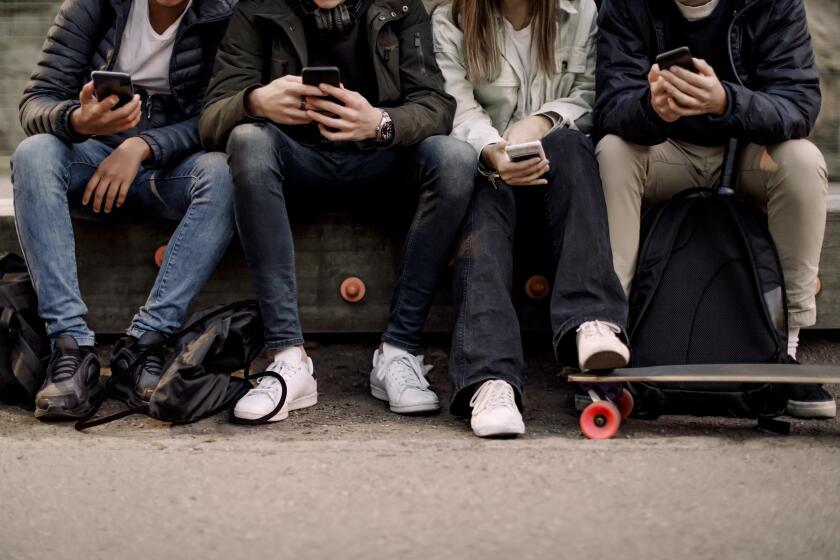Graphic imagery online can lead to psychological harm, UC Irvine experts say

- Share via
Photos showing the bloodied face of former President Trump have been plastered across social media platforms and news outlets in recent days, along with a video of his alleged assailant opening fire at the candidate during a rally Saturday in Pennsylvania.
Also inescapable were images of the three other people shot at the event, one fatally, and of the alleged shooter’s body after he was killed by snipers.
These were the latest examples of the carnage that’s often displayed online, but by no means the most graphic ones. Since Oct. 7, the internet has been awash in images of the death and destruction wrought by Hamas’ attack inside Israel and Israel’s crushing response in Gaza.
UC Irvine researchers say repeated exposure to graphic photos and videos is being linked to psychological distress. Experts say it’s important to understand how these images can affect your mental health and recognize when to take a break or reduce your exposure.
Roxane Cohen Silver and E. Alison Holman are researchers and professors in Irvine’s department of psychological science who have been studying the public-health effects of graphic images, including those from the Sept. 11, 2001, terror attacks; the Boston Marathon bombing in 2013; and the 2016 Pulse nightclub shooting in Orlando, Fla.
In studying people’s repeated exposure to graphic images immediately after these events and over time, they found a correlation to acute stress, post-traumatic stress symptoms, fear of future attacks and difficulty functioning in work and social life.
Jonathan Haidt’s “The Anxious Generation” feeds the latest technology panic. But the research says something different.
A significant change noted by their studies is in how people are consuming these images or videos. People watched the devastation from the 9/11 attacks on the television or read about it in the newspaper; whatever images they saw were chosen by an editor, Holman said.
Hours of television exposure in the immediate aftermath of the attacks was correlated acute stress symptoms in a national sample of viewers outside New York City. Of the same sample, at least 6% had high levels of post-traumatic stress symptoms six months later, according to Holman and Silver’s published perspective in the Proceedings of the National Academy of Sciences.
In the case of the Boston Marathon bombing, the team found that the more often a person saw graphic images from the attack, the more highly correlated the exposure was to post-traumatic stress, fear of terrorism and poorer daily functioning.
Violent events haven’t stopped in the U.S. or around the globe, but our way of viewing such incidents and the frequency of it has.
In the last several years, people have been getting their information increasingly from nontraditional news sources on social media that are largely unfiltered, Holman said.
As the COVID-19 pandemic was unfolding and people were home with not much to do, Silver said, people often would “doomscroll” from one negative news clip to another and another, mainly encountering images of tragedy.
Amid huge demand for Ozempic and other drugs that trigger weight loss, the social media giant announces new community guidelines in an effort to promote positive body image.
In the past, Silver said, you had to seek out information about an incident from televised news reports or printed articles. Now with social media platforms, “it’s difficult to avoid these kinds of images.”
More recently, social media users have witnessed devastation and death from the war in Gaza across their social media feeds, whether it be livestreams or posted videos.
Holman and Silver’s research suggests that people search for this information because they’ve been exposed to such graphic images before, want to be informed about the incident or have some type of relation to the victims.
“My colleagues and I would never advocate that people should not know what’s going on in the world,” Holman said. “We need to understand what’s happening in the world around us.” But we need to be able to do so “in a way that doesn’t totally traumatize us and leave us distressed and at risk for heart health problems.”
Holman strongly suggests ditching social media as a means for getting news and instead finding a traditional news source to catch up on what’s happening locally or in the world.
She recommended allotting yourself a certain amount of time for consuming the news; Holman gives herself about 30 minutes, but says it varies by the individual. You can tell when it’s time to stop reading or viewing images about a tragedy by understanding how you’re reacting to what you’re seeing.
How is your body reacting
To circumvent feelings of distress, Silver says she avidly tries to avoid graphic and violent images altogether. To keep up to date with current events, Silver says she reads new articles online and chooses not to view images or video that include violence.
Another way Silver dodges graphic content is by staying off social media.
But many people don’t have the ability to shield themselves from the proliferation of graphic images online, so Holman said it’s important to recognize how your body is reacting to the exposure.
When Holman is sees images or news that’s distressing or upsetting and is caught up in consuming the information, she said she finds herself breathing faster or her heart pumping faster.
She might get agitated and start making comments out loud, like, “My God, what is wrong with people?” or “I can’t believe this.”
These reactions, Holman said, indicate that she’s seeing things she cannot deal with, and that’s a sign that she’s consuming too much of the graphic or violent information.
When this happens, Holman said, she takes a deep breath and decides to finish the article or video later — or end her consumption for the day altogether.
The U.S. surgeon general has called on Congress to require warning labels on social media platforms similar to those mandatory on cigarette boxes.
Limiting your consumption of graphic images
Social media platforms use unique algorithms to determine what individual users will see in their feeds. Algorithms are “usually selecting information that boosts user engagement to increase advertising revenue,” according to Northwestern University scientists.
In a review published in the journal Trends in Cognitive Sciences, the authors wrote that social media feeds are oversaturated with “prestigious, in-group, moral and emotional information,” or information that users are strongly biased to learn from.
As a user you might land on a graphic video from the war in Gaza, watch a few seconds and move on, but several videos later and you might see another video from a different source. The algorithm makes it harder to avoid war-related content because you’ve engaged with it, so the algorithm assumes you’ll engage with more items like it.
On the largest social networks, at least, users aren’t taken by surprise by the graphic content. On Instagram and TikTok there’s a message displayed before the video or photo that says “sensitive content” and allows users to decide whether they want to proceed.
If you’re trying to eliminate your exposure to graphic videos or images on social media altogether, you can change your account preferences and get the content off your feed.
Here’s how various social media sites label graphic content and how to change your feed to exclude it:
- On YouTube you can turn “restriction mode” on or off; it’s typically off for viewers by default. Turning it on removes mature content, which includes videos that show drugs and alcohol, sexual situations, violence, political conflicts (including war, crime or terrorism that results in death or serious injury), profane language and demeaning content.
- Instagram has step-by-step instructions online, accessible from your privacy settings, on how to see less “sensitive content” in your feed. This can be content that depicts violence, discusses self-harm or suicide, is sexually explicit or suggestive, or promotes products such as tobacco vaping pens.
- X, formerly known as Twitter, allows you to control whether you’ll see sensitive media in posts.
- Facebook allows you to manage your feed by using the “reduce” option in your account settings. It’ll give you an option to further reduce graphic or violent content.
Checking a post for accuracy
When you are scrolling through social media and seeing graphic or violent content, bear in mind that it might not always be accurate. Holman warns that users shouldn’t rely on a social media platform as their news source because “it’s a place where you can get stuff that looks like news but it’s not.”
One way to gauge whether the information you’re seeing on social media is legitimate is to check the source. Johns Hopkins University’s Sheridan Libraries have a checklist to help users verify and determine the accuracy of the information. They suggest examining:
- The location of the poster. Is the poster at the place they’re tweeting or posting about?
- The account’s followers. Who is following the account, and who does the account holder follow?
- Confirming sources. Can the information that’s been posted on the account be corroborated from other sources?
- Contextual updates. Does the user usually post on this topic? If so, what did past or updated posts say?
- The age of the account. When was the account created? Hopkins recommends that social media users be wary of recently created accounts.
Images or videos can be not only inaccurate, but also taken out of context or mischaracterized. For example, last year The New York Times reported a video circulating on X of a boy crying out for siblings lost in the chaos of an airstrike, a scene purportedly from the war in Gaza. In fact, the video was from the war in Syria a decade earlier.
More to Read
Sign up for Essential California
The most important California stories and recommendations in your inbox every morning.
You may occasionally receive promotional content from the Los Angeles Times.














